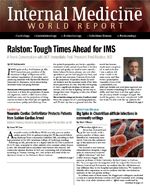Publication
Article
Internal Medicine World Report
COPD Prevalence Depends Upon Classification Guideline Used, but Mild Cases Have Little Effect on Prognosis
COPD Prevalence Depends Upon Classification Guideline Used, but Mild Cases Have Little Effect on Prognosis
Study Shows COPD Prevalence Highly Dependent on Diagnostic Standard Used, but Finds That Comorbidity and Age Are Chief Predictors of Prognosis
By Todd Kunkler
S
tudies have shown that chronic obstructive pulmonary disease (COPD) can have a negative effect on independence and survival in the general population, but the extent to which COPD, especially mild cases, affects elderly patients is unknown. To ascertain the effect of COPD on this population, a recent study looked at data from “a large collaborative study on respiratory health in elderly people” to verify “the association between mild COPD, defined according to different algorithms, and mortality and functional status in a sample of elderly (aged 65 to 74 years) and very elderly (aged ≥75 years) patients.”
The authors of “Does Mild COPD Affect Prognosis in the Elderly?” noted that COPD “has as [a] key feature the reduction of forced expiratory volume in 1 second (FEV1) relative to the vital capacity (VC) or to the forced vital capacity (FVC), and various [cut-offs] of the FEV1/FVC ratio have been proposed to diagnose this disease.” However, various classification guidelines propose the use of different FEV1/FVC ratios as diagnostic standards: the British Thoracic Society and the UK National Institute for Clinical Excellence call for “FEV1/FVC less than 0.7 and FEV1 less than 80% predicted” for a diagnosis of COPD, whereas the Global Initiative for Chronic Obstructive Lung Disease (GOLD) guidelines say that a FEV1/FVC less than 0.7 should be the diagnostic standard (with a separate “GOLD class II” designation used for patients who also have a FEV1 <80% predicted). The 2004 European Respiratory Society (ERS)/American Thoracic Society (ATS) guidelines use an FEV1/FVC ratio of 0.7.
Because there is a relative lack of evidence on the “prognostic significance of the different classification methods” for COPD, and because FEV1 “has been shown to have important prognostic implications” for patients with COPD, the authors wrote that “it is reasonable to question what is the prognosis of people classified as having mild obstruction according to the ATS/ERS or GOLD classification (ie, with normal FEV1) compared to those classified as having mild obstruction according to the British Thoracic Society (BTS) classification (ie, with reduced FEV1).” Accordingly, they analyzed data from the Respiratory Health in the Elderly (Salute Respiratoria nell’Anziano [SaRA]) study and “compared the differences between the classification systems with regards to personal capabilities and 5-years survival, focusing on the mild stage of COPD.”
For this study, the authors examined spirometry data for more than 1700 SaRA study participants, excluding data that did not meet the standards of the ATS recommendations for diagnostic spirometry. The final sample size was 1159 (48.7% women, mean age 73.2 years, 37% of subjects 75 years or older). Patients met at least 1 of 3 definitions of bronchial obstruction:
•
FEV1/FVC <LLN; FEV1 >70% predicted (ATS/ERS)
•
FEV1/FVC <0.7; FEV1 between 50% and 80% predicted (BTS/National Institute for Clinical Excellence)
•
FEV1/FVC <0.7; FEV1 ≥80% predicted (GOLD)
The researchers “evaluated the prognostic significance of mild COPD against a control group representative of the general elderly population.” They measured performance capacity using the distance walked in 6 minutes (6MWD) and examined subjects’ cognition and mood status using the Mini-Mental State Examination (MMSE) and the Geriatric Depression Scale (GDS). They also devised a “reference indicator of prognosis” based on “body mass index, severity of bronchial obstruction, dyspnea, and exercise capacity.” To assess the impact of mild COPD on health status, they “compared the 6MWD, Barthel index, MMSE, and GDS of control subjects and COPD patients alternatively grouped according to each of the 3 classifications.”
Analysis of data showed that overall prevalence of bronchial obstruction was 40.0% (according to the ATS/ERS definition), 28.5% (BTS), and 43.6% (GOLD). Among participants aged 65 to 75 years, “mild obstruction was present in 18.8%, 18.5%, and 10.8% using the ATS/ERS, BTS, and GOLD classification, respectively.” The authors reported “similar” prevalence of mild obstruction among older participants using the ATS/ERS and BTS classifications; using the GOLD definition, prevalence increased to 22.4% “compared to the one observed in the group aged 65 to 75 years.”
The authors concluded that these results confirmed that “the estimated prevalence of COPD depends on the definition used, but ‘mild’ COPD, regardless of the definition used, impacts neither prognosis nor personal capabilities in an elderly population.”
Author Disclosures:The authors reported no conflicts of interest.
Source: Pedone C, Scarlata S, Sorino C, Forastiere F, Bellia V, Antonelli Incalzi R. Does mild COPD affect prognosis in the elderly? BMC Pulm Med. 2010;10:35.
